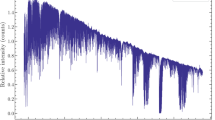Abstract
We analyze physical characteristics of late-type stars wherein the Kepler mission registered superflares. We use the revised stellar fundamental parameters, i.e. effective temperatures Teff and surface gravity accelerations log g, from the Kepler archive published in 2017, as compared to previous studies by Balona (2015) based on the release of 2011. Among superflare stars there are both single objects and members of eclipsing binaries. We select the late-type stars (with Teff < 6500 K) wherein occured the most powerful flares with the total flare energy >1035 erg and consider their locations in the Teff – log g diagram. Both components of binaries and single stars appear to reside mostly in between the main sequence and the subgiant branches and therefore have larger radii compared to that of the Sun. Besides, as a rule these single stars are fast rotators and can be considered as young objects that it is difficult to attribute to “solar-type stars”. Extremely high flare energy of these stars requires quite strong magnetic fields that cannot be generated even due to scaling of the solar dynamo. Apparently, for explanation of the strongest non-stationary phenomena on stars considered, it would be worthwhile to attract another regime of the dynamo mechanism that can be realized in these objects.




Similar content being viewed by others
REFERENCES
Balona, L., Flare stars across the H-R diagram, Mon. Not. R. Astron. Soc., 2015, vol. 447, pp. 2714–2725.
Brown, T.M., Latham, D.W., Everett, M.E., and Esquerdo, G.A., Kepler input catalog: Photometric calibration and stellar classification, Astron. J., 2011, vol. 142, no. 4, id 112.
Huber, D., Silva Aguirre, V., Matthews, J., Pinsonneault, M., et al., Revised stellar properties of Kepler targets for the quarter 1–16 transit detection run, Astrophys. J., 2014, vol. 211, no. 1, id 2.
Katsova, M.M. and Livshits, M.A., The origin of superflares on G-type dwarf stars of various ages, Sol. Phys., 2015, vol. 290, pp. 3663–3682.
Katsova, M.M., Kitchatinov, L.L., Livshits, M.A., Moss, D.L., Sokoloff, D.D., and Usoskin, I.G., Can superflares occur on the Sun? A view from dynamo theory, Astron. Rep., 2018, vol. 62, no. 1, pp. 72–80.
Livshits, M.A., Rudenko, G.V., Katsova, M.M., and Myshyakov, I.I., The magnetic virial theorem and the nature of flares on the sun and other g stars, Adv. Space Res., 2015, vol. 55, no. 3, pp. 920–926.
Maehara, H., Shibayama, T., Notsu, S., et al., Superflares on solar-type stars, Nature, 2012, vol. 485, no. 7399, pp. 478–481.
Maehara, H., Shibayama, T., Notsu, Y., et al., Statistical properties of superflares on solar-type stars based on 1-min cadence data, Earth Planets Space, 2015, vol. 67, id 59.
Maehara, H., Notsu, Y., Notsu, S., et al., Starspot activity and superflares on solar-type stars, Publ. Astron. Soc. Jpn., 2017, vol. 69, no. 3, id 41.
Mathur, S., Huber, D., Batalha, N.M., et al., Revised stellar properties of Kepler targets for the Q1-17 (DR25) transit detection run, Astrophys. J. Suppl. Ser., 2017, vol. 229, no. 2, id. 30.
Shibayama, T., Maehara, H., Notsu, S., et al., Superflares on solar-type stars observed with Kepler. I. Statistical properties of superflares, Astrophys. J. Suppl. Ser., 2013, vol. 209, no. 1, id 5.
Straižys, V. and Kuriliene, G., Fundamental stellar parameters derived from the evolutionary tracks, Astrophys. Space Sci., 1981, vol. 80, pp. 353–368.
Author information
Authors and Affiliations
Corresponding authors
Additional information
The article is published in the original.
Rights and permissions
About this article
Cite this article
Katsova, M.M., Nizamov, B.A. Properties of Kepler Stars with the Most Powerful Flares. Geomagn. Aeron. 58, 899–904 (2018). https://doi.org/10.1134/S0016793218070095
Received:
Accepted:
Published:
Issue Date:
DOI: https://doi.org/10.1134/S0016793218070095




